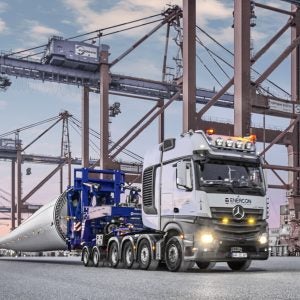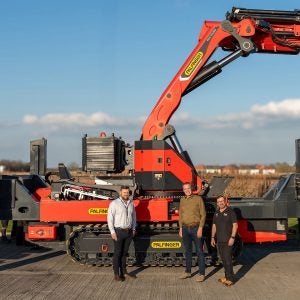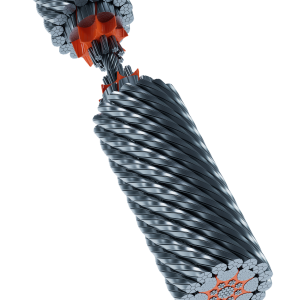Elaine Fischer, from L&I’s communications services department, explains: “Washington State regulations say the crane manufacturer (in this case, both manufacturers) needs to give approval for any modifications. We’d not seen hybrid cranes before. In our state, not only had we not seen them, we’d not heard of them. Our rule doesn’t specifically address using parts from two manufacturers; it addresses any modifications.”
Washington State’s crane safety law requires that any crane modifications not affect the overall safety of the crane. A report from professional engineers Caspar, Philips and Associates on the hybrids supports both sides of the argument about whether to use hybrids. On the one hand, it showed that the towers were safe: it confirmed that the two cranes met international standards (FEM standards) for wind speed.
On the other hand, the engineers’ report showed that using hybrid components can affect safety. Fischer says, “In this case, the engineer’s report said that the maximum wind velocity was lower, so the safety factor was reduced.” A statement issued by L&I, when the cranes were shut down, said, “The analysis recommends not operating the hybrid cranes during wind speeds of 25 mph for one of the cranes and 33 mph for the other. That is significantly less than the 45-mph approval rating assigned by the manufacturers of the original cranes.” This reduction in safety factor, Fischer says, contributed to the agency’s decision to shut down the cranes.
Lewis Equipment marketing director Jeff Pedigo counters that the practice of using hybrid parts is common: “Hybrid cranes are used worldwide. Like any steel structure (crane or building) when used they should be engineered to ensure they can safely perform the job at hand. We diligently work with our general contractors and engineers to ensure we erect the right crane to get the job done, safely.
“These three cranes were the first our company erected in Washington. The scenario, which was blown way out of proportion, has been resolved. It was not that the cranes were ever unsafe, we just needed to comply with all of Washington’s codes. All three cranes in Washington are [now] flying safe and sound. We now have good working relationships with L&I and the general contractors in Washington and more SunCrane tower cranes are on the way up soon.”
Both or one?
Fischer at L&I adds that the other issue of concern was about consultation. She says: “We don’t see how one manufacturer can speak for the other. Terex-Comedil told us, ‘The use of our tower crane sections, in conjunction with other manufacturers components, is specifically prohibited.’”
Terex Cranes president Rick Nichols explains why the company doesn’t approve of hybrid cranes: “Safety is imperative in our business. We don’t have the designs for SunCrane products: We don’t know how one is designed, how it is built, what the material properties are. By not knowing how the competitor’s equipment is designed, we’re leery of having our components used in this combined way. We only want our components used with OEM parts. For the safety of all involved, Terex does not authorise the use of non-OEM parts on Terex Comedil tower cranes.”
The case for requiring approval from both manufacturers seems clear. As Nichols and Fischer both point out, how can one manufacturer be sure that a competitor’s components will work in combination with their own, without reducing the overall safety of the crane? In this case, while the professional engineer said the crane was safe, Fischer argues that his report showed that safety had been reduced. Does this indicate that all crane safety legislation should require approval from both manufacturers? Nichols is certain it should. Asked if he preferred regimes where Terex can control how its components are used, he told Cranes Today, “Yes. That is the only way Terex can determine all components are safe to use on a Terex crane.”
The case for hybrids
However, there are reasons why crane manufacturers and importers would want to erect hybrids. One tower crane expert with experience in developing safety standards, who did not wish to be named, points out, “If all you have to worry about is what’s above the mast, it saves your development time and costs. Some of the demand [for top sections that can be used with other manufacturers’ mast sections] comes from customers: if you have a yard full of mast sections, you don’t want to have to buy new ones. That’s one reason why tower crane owners end up focusing on a single manufacturer.”
Lewis is not the only company that wants the option to set up hybrid cranes. At least two of Europe’s new tower crane manufacturers developed their products with hybrid cranes in mind. Both companies’ designers had years of experience designing cranes for other manufacturers, and had an in-depth knowledge of the design of the other companies’ mast sections.
For these companies, legislation like Washington’s, which specifically requires approval from both manufacturers, would have made it harder to develop new crane designs, and harder to sell them to customers with existing stocks of mast sections. Legislation needs to allow innovative concepts to be developed and sold as efficiently as possible, but without compromising safety. How can it do so without giving crane manufacturers a veto over the use of their components in combination with competitors?
In the UK, the standard covering tower cranes is BS 7121 Part 5. Clause 12.3.1 of the standard says, “The interchange of structural components between one model of tower crane and another may occur if the manufacturer has given approval. Having carried out such an interchange, a tower crane should be retested in its new combination, and the interchanged parts should be specified on the test certificate.”
It continues: “When a tower crane is erected using components from two or more manufacturers, it is essential that the written agreement of at least one of the manufacturers, where they remain available, is obtained before erection starts. In the absence of the manufacturers, the combination of components should be approved by a competent design authority.”
If the Seattle case had happened in the UK, Lewis would have been able to erect the cranes in accordance with BS 7121, so long as a ‘competent design authority’ had approved the combination of parts. However, this raises the question of what it means to be a ‘competent design authority’.
As part of the European Union, the UK requires all new machinery to be CE-marked; that is, it should meet all the requirements of the Machinery Directive. The EU Machinery Directive points to the sort of experience that is required for a designer to be considered competent. Under the directive, a new machine includes both products developed from scratch, and products that are significantly modified. Where a machine is modified (by, in this case, combining components from two different sources) the company making the modification is considered the manufacturer.
To comply with the directive, the manufacturer must prepare a detailed technical filing. To be able to prepare the filing properly, it will need to be familiar with all of the design characteristics of both component manufacturers’ products. In the case of the two new manufacturers mentioned above, their designers would be able to point to their previous experience working for competitors as evidence of this knowledge. For a fleet owner like Lewis, it would be necessary to employ consultants who could demonstrate the same experience.
Clearly, the level of technical experience needed to develop and sell crane components for use in hybrid towers is high. However, well-drafted legislation can make it possible for this to happen without compromising safety.






